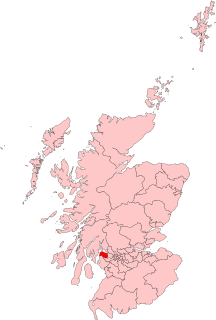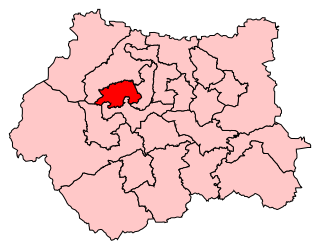
Aberavon is a constituency represented in the House of Commons of the Parliament of the United Kingdom since 2015 by Stephen Kinnock of the Welsh Labour Party. It includes the town of Aberavon, although the largest town in the constituency is Port Talbot.

Neath is a constituency represented in the House of Commons of the UK Parliament since 2015 by Christina Rees, a Labour and Co-operative MP.

Inverclyde is a parliamentary constituency of the House of Commons of the Parliament of the United Kingdom. It replaced Greenock and Inverclyde and the Port Glasgow and Kilmacolm areas from West Renfrewshire for the 2005 general election.

East Renfrewshire is a constituency of the House of Commons, to the south of Glasgow, Scotland. It elects one Member of Parliament (MP) using the first-past-the-post system of voting.

Bradford West is a constituency represented in the House of Commons of the UK Parliament since 2015 by Naz Shah of the Labour Party.
Glasgow Springburn was a constituency of the House of Commons of the Parliament of the United Kingdom from 1918 until the 2005 general election, when it was largely replaced by the Glasgow North East constituency.
Glasgow Cathcart was a burgh constituency represented in the House of Commons of the Parliament of the United Kingdom from 1918 until 2005, when it was replaced by the larger Glasgow South constituency.
Glasgow Govan was a parliamentary constituency in the Govan district of Glasgow. It was represented in the House of Commons of the Parliament of the United Kingdom for 120 years; from 1885 until 2005, returning one Member of Parliament (MP) elected by the first-past-the-post system.
Glasgow Hillhead was a parliamentary constituency represented in the House of Commons of the Parliament of the United Kingdom from 1918 until 1997. It elected one Member of Parliament (MP) using the first-past-the-post voting system.

Glasgow Shettleston was a burgh constituency represented in the House of Commons of the Parliament of the United Kingdom from 1918 until 2005. The Shettleston area's representation is now covered by Glasgow Central and Glasgow East.
Glasgow Maryhill was a parliamentary constituency represented in the House of Commons of the Parliament of the United Kingdom from 1918 to 2005 when it was subsumed into the new Glasgow North and Glasgow North East constituencies. It elected one Member of Parliament (MP) using the first-past-the-post voting system.
Glasgow Garscadden was a burgh constituency represented in the House of Commons of the Parliament of the United Kingdom from 1974 until 1997. It elected one Member of Parliament (MP) using the first-past-the-post voting system.

West Renfrewshire was a county constituency of the House of Commons of the Parliament of the United Kingdom from 1885 to 1983 and again from 1997 until 2005. In 2005 the constituency was abolished and the area is now represented by Inverclyde, Paisley and Renfrewshire North and Paisley and Renfrewshire South.

Linlithgow was a county constituency of the House of Commons of the Parliament of the United Kingdom from 1983 to 2005. It elected one Member of Parliament (MP) by the first past the post system of elections.
Glasgow Anniesland was a burgh constituency represented in the House of Commons of the Parliament of the United Kingdom from 1997 until 2005, when it was replaced by the larger Glasgow North West, with the exception of Kelvindale which joined Glasgow North.
Glasgow Baillieston was a burgh constituency of the House of Commons of the Parliament of the United Kingdom. It elected one Member of Parliament (MP) using the first-past-the-post voting system.
Glasgow Kelvin was a parliamentary constituency represented in the House of Commons of the Parliament of the United Kingdom from 1997 until 2005. The area it represented is now covered by Glasgow Central, Glasgow North and Glasgow North West.
Renfrew West and Inverclyde was a constituency of the House of Commons of the Parliament of the United Kingdom from 1983 to 1997.

Greenock and Inverclyde is a constituency of the Scottish Parliament (Holyrood) covering most of the council area of Inverclyde. It elects one Member of the Scottish Parliament (MSP) by the first past the post method of election. It is also one of ten constituencies in the West Scotland electoral region, which elects seven additional members, in addition to the ten constituency MSPs, to produce a form of proportional representation for the region as a whole.
Greenock and Port Glasgow was a burgh constituency of the House of Commons of the Parliament of the United Kingdom from 1974 until 1997, electing one Member of Parliament (MP) by the first past the post system of election.









